“That Darn Catwoman” / “Scat! Darn Catwoman”
Written by Stanley Ralph Ross
Directed by Oscar Rudolph
Season 2, Episodes 40 and 41
Production code 9743
Original air dates: January 19 and 25, 1967
The Bat-signal. Robin is giving a commencement speech at Aaron Burr High School. (Why someone who hasn’t actually graduated high school yet is giving a high school commencement is left as an exercise for the viewer.) He’s approached afterward by Pussycat, who is Catwoman’s protégé. (She’s actually a rock and roll star, but Catwoman has recruited her to be her sidekick, since at age twenty, she’s already over-the-hill to be a rock star…). She scratches Robin with a cataphrenic, which turns Robin to a punk. The boy wonder actually slams O’Hara into a wall and then goes off with Pussycat.
Upon learning of this assault on a police officer, Gordon immediately calls Batman almost apologetically. Batman drives to police HQ, alone for once (thus requiring new footage of Batman driving alone and only using stock footage that shows the Batmobile from enough of a distance that you can’t tell who’s in it), and Gordon and Batman question O’Hara. The chief says that he was talking to some redhead, and then tripped him. (Which is odd, as Robin actually shoved him.)
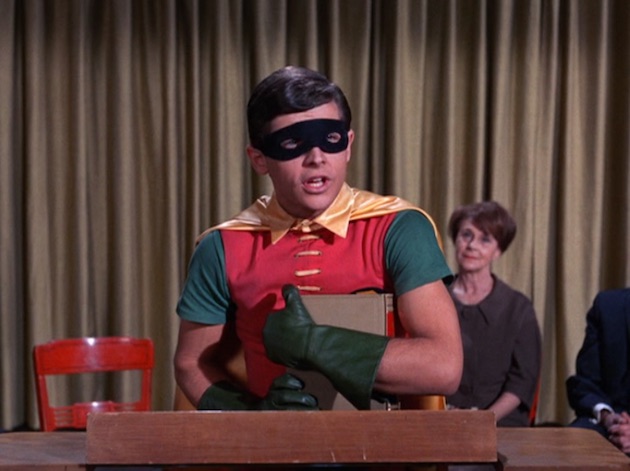
Back at Wayne Manor, Harriet asks why she’s not allowed in Bruce’s study. Alfred’s lengthy and offensive diatribe on the subject of having a masculine retreat away from female encroachment is mercifully interrupted by Catwoman, Robin, Pussycat, and her three thugs entering Wayne Manor. They tie up Alfred and Harriet, blow open the safe, and steal two hundred thousand dollars.
Alfred calls on the Bat-phone, which surprises Batman and Gordon. Probably hoping it was Robin, instead it’s a report from Alfred, including the information that Robin is suffering from amnesia and dizziness. (He’d fainted at the end of the robbery.)
The camera cuts away before Batman has to explain to Gordon and O’Hara to whom, exactly, he was talking to on the phone, as we look in on Catwoman. Robin is sleeping off his fainting spell, and Pussycat, despite Catwoman’s protestations, practices her new song, “California Nights,” which sounds exactly like Lesley Gore’s hit single of the same name! What a coinky-dink!
Once Pussycat’s done with the song, Catwoman gets down to business: they need eight hundred thousand more dollars and also Batman. She calls Gordon and has him put her through to Batman. He puts his phone and the Bat-phone ear-to-mouthpiece (which would make for a terrible connection), and Catwoman makes her play. If the police or Batman try to stop her upcoming series of robberies, Robin will die. She offers to meet Batman on neutral ground to discuss it, but he refuses.
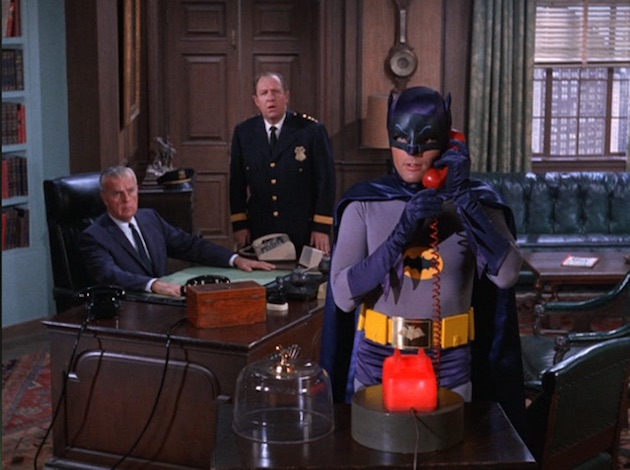
After the call, Batman says he must handle this in his own way, and Gordon shouldn’t make any attempt to stop her nor be surprised by anything Batman does.
Catwoman steals another hundred thousand, but they still have seven hundred thousand to go. So she goes off with the thugs to rob more money while Pussycat guards the loot.
We cut to the workshop of Pat Pending, described as the world’s cheapest inventor, where he’s discovered a universal solvent, though Rudy the valet points out that there’s no container that would hold it.
Then Catwoman comes in and steals all his cash, which he keeps hidden in his mattress. Afterward, Pending and Rudy report that she mentioned something about a prince getting weighed. Gordon and O’Hara recall that Prince Ibn Kereb of Gedallia is weighed in every year: they put paper money on the other side of the scale to weigh him, and the money is then given to Gedallia’s orphans.
Catwoman, Robin, Pussycat, and the thugs show up to steal the money, but Batman is waiting for them. He’s appalled to realize that Robin doesn’t recognize him. Fisticuffs ensue, and Batman takes out the three thugs in short order. However, while he does so, Catwoman, Robin, and Pussycat put the prince’s money in a bag. Catwoman orders Robin to beat up Batman, which he does gleefully—and successfully, since Batman can’t bring himself to strike his old chum.

Jumping into the Catillac, Catwoman and her gang go to their headquarters in New Guernsey. Batman follows, and calls Gordon that he thinks he’s found a second Catlair. This surety is borne of the three signs on the door to the lair, which say, “SECRET ENTRANCE TO CATLAIR WEST!” “THIS MUST BE THE PLACE,” and “CATWOMAN’S IN HERE!”
He enters to find Robin tied to a chair. Thinking Robin was playing possum the whole time, he frees Robin—which distracts him long enough for the thugs to stun him with electrodes. He wakes up to find himself tied inside a giant mousetrap. Catwoman asks Batman to join her as her partner, which he refuses. So Robin cuts the rope that’s keeping the trap from springing—until Batman gives in. He agrees to become her partner, not to save his own life, but to keep Robin from committing murder.
Catwoman’s about to apply the cataphrenic—to make sure he’s not faking—when Batman asks to take a bat-pill first, to put off a headache. Bitching about how men are hypochondriacs, she lets him, then applies the cataphrenic. Batman starts acting like just as much of a leering doofus as Robin, and they head to the old criminals’ home on Short Island to meet up with Little Al. Catwoman’s been stealing money in order to pay Little Al for the plans to the Gotham City Mint.
Gordon is beside himself. Catwoman has been sighted as a passenger in the Batmobile, and he’s getting calls from Mayor Linseed, Governor Stonefellow, and President Johnson. But then O’Hara comes in with an anonymous tip about the location of the Catlair.
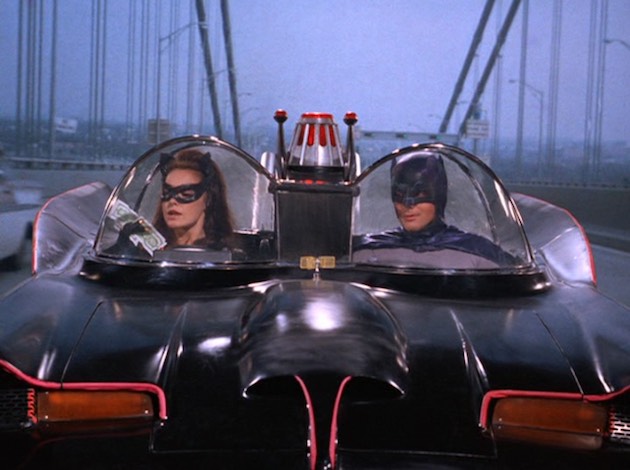
Pussycat is singing “Maybe Now“—another Lesley Gore song (ahem)—to a picture of Robin. Then the boy wonder himself comes into the room and tries to make a move. Pussycat isn’t having any of it, though, as she’s not the type of girl to kiss on a first crime. Robin grabs her and tries to force a kiss on her, which isn’t at all creepy, when Gordon, O’Hara, and two other cops walk in to arrest them. They question Pussycat to no avail, and so Gordon decides to try to trace the Bat-phone.
Batman, Catwoman, and the thugs see Pussycat and Robin being taken to the hoosegow. A frustrated Catwoman tells the thugs to lay low, and she asks if Batman remembers where the Batcave is—at which point he gasses her.
He wakes her up the Batcave and convinces her that she fainted in his arms. She doesn’t question this, partly because she’s overwhelmed by the awesomeness of the Batcave. She also comes onto him, but Batman says they need to focus on the mint robbery first.
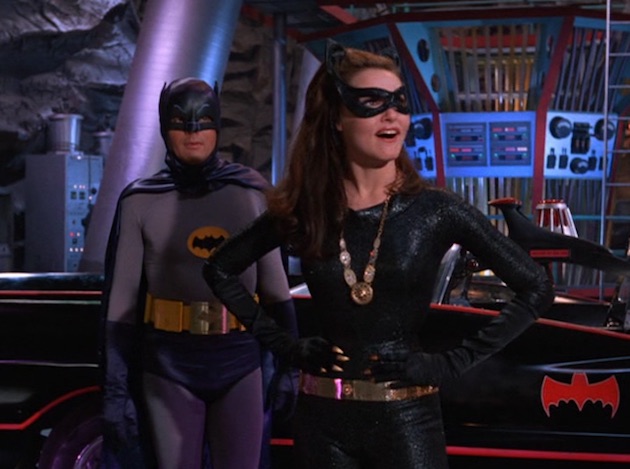
Before Catwoman can try harder, an alarm goes off alerting Batman to Gordon’s attempt to trace the Bat-phone. Batman is able to divert the phone line so that Gordon instead follows the trace to Pending’s lab. Gordon and O’Hara arrest Pending, assuming that Rudy is Robin. Pending’s protestations that he has too much of a paunch to be Batman, not to mention the fact that the 32-year-old Rudy could hardly be the “boy” wonder, fall on deaf ears.
Batman leaves a note for Alfred to take Bat-antidote pills to Robin at police HQ before he gasses Catwoman again to leave the Batcave. They head to the mint (with Catwoman not even questioning the fainting spell). After they break in, Robin shows up, announcing that he’s no longer under the cataphrenic spell—at which point Batman reveals himself to have been faking it long enough to learn the weak spot in the mint’s security. Now that he’s found it (there was a false door), they can take her in. Fisticuffs ensue, but while the thugs are taken care of, Catwoman manages to lift the bat-keys to the Batmobile and get away.
Batman takes O’Hara’s cruiser to give chase and get close enough to take remote control of the Batmobile. They stop it at a warehouse and Batman chases her to the rooftop. He tries to convince her to give up, but she plummets a hundred feet to the West River—to her doom? We’ll never know—well, at least not until she shows up again…

Fetch the Bat-shark repellant! My new favorite bat-device is in this one: the Automatic Bat-Alarm for Detecting Phone Detecting Equipment! You gotta love a device that has the word “detecting” in in twice! He also has the ability to divert a trace on the Bat-phone to another line, which becomes a serious problem for Pending.
Plus we have the old standbys of the Bat-antidote and the Bat-gas. And at the end, he uses a Bat-hanky to catch his tears as he weeps over Catwoman’s apparent demise.
Holy #@!%$, Batman! When Batman frees him from Catwoman’s chair, Robin cries, “Holy nick of time!” When Gordon and O’Hara show up to arrest him and Pussycat, he grumbles, “Holy shucks,” which may be the worst “holy” utterance in the show’s history. Finally, he cries, “Holy diversionary tactic!” when Catwoman escapes in the Batmobile.
Also, William Dozier cries, “Holy bat trap!” during the cliffhanger voiceover.
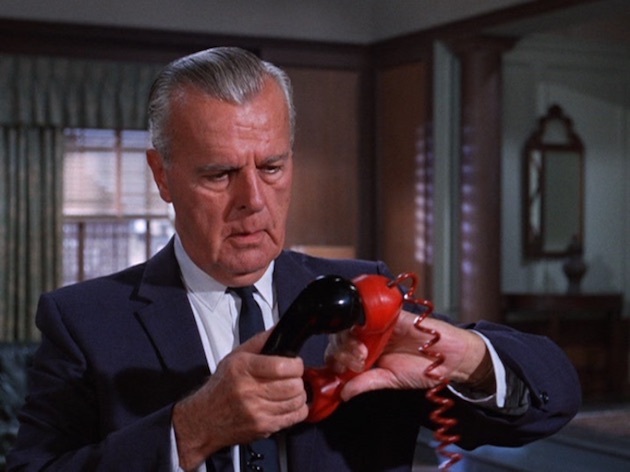
Gotham City’s finest. For a moment, the GCPD approaches competence, as Gordon actually figures out that Catwoman will hit the prince of Gedallia. After that, though, they hardly cover themselves in glory, with Gordon immediately assuming that Batman has gone bad and calling for him to be captured “dead or alive.” He also totally believes that Pending and Rudy are Batman and Robin.
O’Hara doesn’t fare much better: Robin shoves his ass right into a wall and later he says that he saw Catwoman got away in the Batmobile, something it never occurs to him to mention until Batman prompts him.
Also at one point Gordon says that he’s violently opposed to police brutality. Okay, then.
Special Guest Villainess. Julie Newmar is back for another go-round as Catwoman, having last appeared as the Sandman’s partner in “The Sandman Cometh”/”The Catwoman Goeth.” Despite jumping to her apparent doom, four stories hence she’ll be back in “Catwoman Goes to College” / “Batman Displays his Knowledge.”
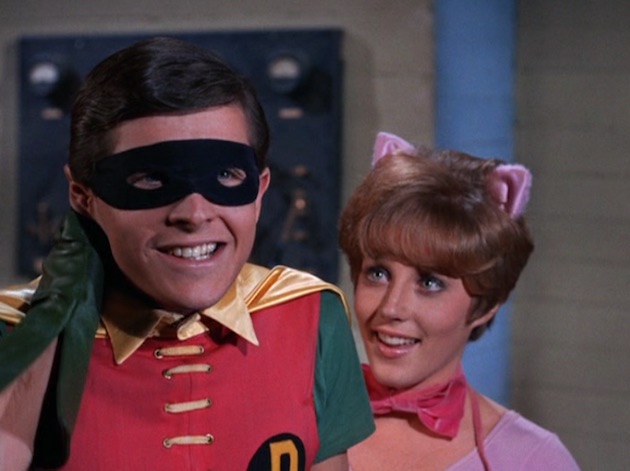
No sex, please, we’re superheroes. Pussycat comes onto Robin in the beginning, though he doesn’t return the interest until after he’s scratched with cataphrenia.
Catwoman also comes on to Batman, particularly in the Batcave and before the mint heist. But Batman deflects her the first time with his faux eagerness to commit crimes, and the second time she’s interrupted by the thugs showing up to commit those crimes.
Na-na na-na na-na na-na na.
“I wanna be alone with you, Robin.”
“Alone with me? But why?”
“I can see a very important part of your education has been grossly neglected.”
–Pussycat making a pass at Robin, and Robin getting an incomplete pass.
Trivial matters. This episode was discussed on The Batcave Podcast episode 38 by host John S. Drew with special guest chum Dan Greenfield of 13thDimension.com.
Guest star Lesley Gore was a very successful pop star, having scored a #1 hit with “It’s My Party” in 1963 when she was only sixteen. “California Nights” actually debuted in “That Darn Catwoman.” Gore is also the niece of producer Howie Horwitz, which probably isn’t a coincidence…
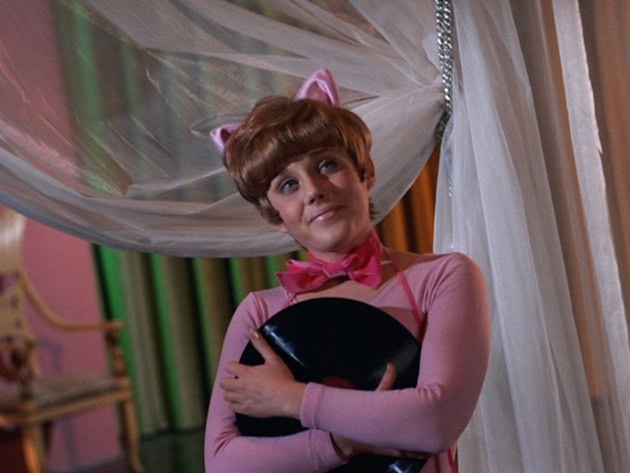
All the New York references in this one: besides Mayor Linseed and Governor Stonefellow (plays on Mayor Lindsay and Governor Rockefeller, the mayor of New York City and governor of New York state at the time), we’ve got New Guernsey across the river (New Jersey is across the river from NYC, and both Jersey and Guernsey are types of cows), Short Island (a play on Long Island, just to the east of NYC), and the West River (a play on the East River).
While it isn’t specified that Gordon gets a call from President Lyndon Baines Johnson, the commissioner does sit up very straight, speak far more formally, and closes the call with “Give my best to Hubert,” referring to Johnson’s vice president, Hubert Humphrey.
Stanley Ralph Ross originally named the prince who weighed himself Missentiff of Furderber, named after a friend of his, but the network thought it sounded too much like an insult and asked him to change it. So he changed it to Kereb, which means “son of a bitch” in Arabic, which blew right past the network.
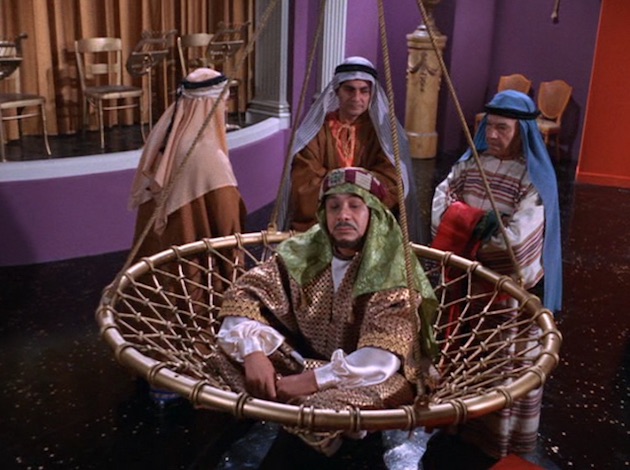
Pow! Biff! Zowie! “Close your eyes and pucker and don’t worry about your reputation.” Usually one can count on a Stanley Ralph Ross script to be among the higher echelon of Bat-scripts, but he’s done in by any number of issues, not all of them his fault. For one thing, while the idea of Catwoman adopting a sidekick on the theory that Batman has one, too is a good one, the execution suffers from the warping effect of Lesley Gore’s pop career. The action of the two-parter grinds to a screeching halt twice so that Gore can lip-sync a hit single.
A good story could be told about how Robin and Batman can both be turned bad, but it’s done in by the simply terrible acting of the principles. Adam West doesn’t actually do too bad with it, and he’s helped by the fact that Batman is faking. Robin isn’t faking, though, and it’s just awful. His bad-guy act is even less convincing than it was in “He Meets His Match, The Grisly Ghoul,” starting with his doofy laughter and only getting worse as the two-parter progresses. At least he suffers dizzy spells so he can be asleep and off-camera for big chunks of the story, which is all for the best.
Catwoman doesn’t cover herself in glory here, either. Stealing a million dollars so she can buy the plans to the mint just seems unnecessarily complicated. It’s also blindingly obvious that Batman took a universal Bat-antidote rather than a Bat-aspirin, and the fact that Catwoman didn’t cotton to that—or to Batman gassing her, not once, but twice to avoid letting her know the Batcave’s location just makes her out to be an idiot.
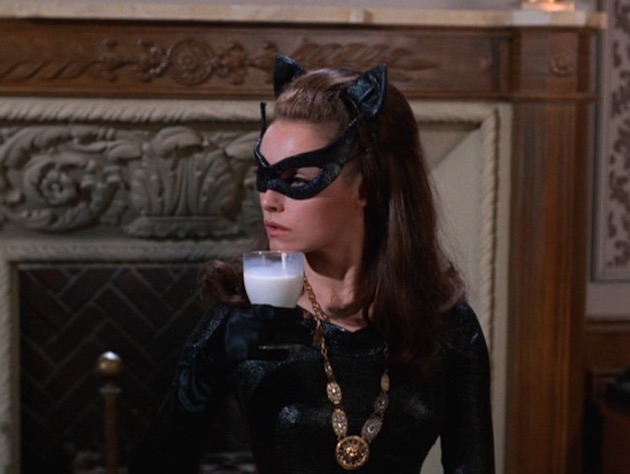
And Catwoman deserves better, as Julie Newmar still shines like a big giant shining thing. As ever with her appearances, the best parts are when West and Newmar get to play off each other, and they do so splendidly in the climactic rooftop confrontation. Batman tries to get her to reform, and she turns it into a marriage proposal, and she also proves that reforming is a problem for her given that her solution to Robin being in the way of their theoretical wedded bliss is to kill the boy wonder.
Bat-rating: 4
Keith R.A. DeCandido is very grateful to be back at rewatching. Moving to a new place has been insane…













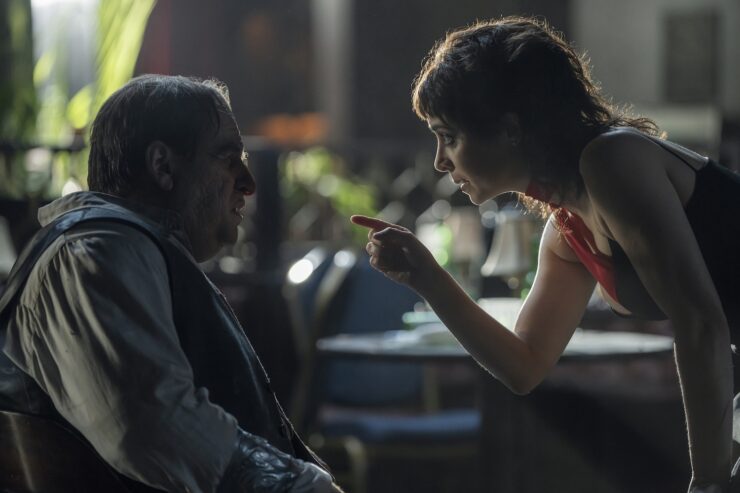
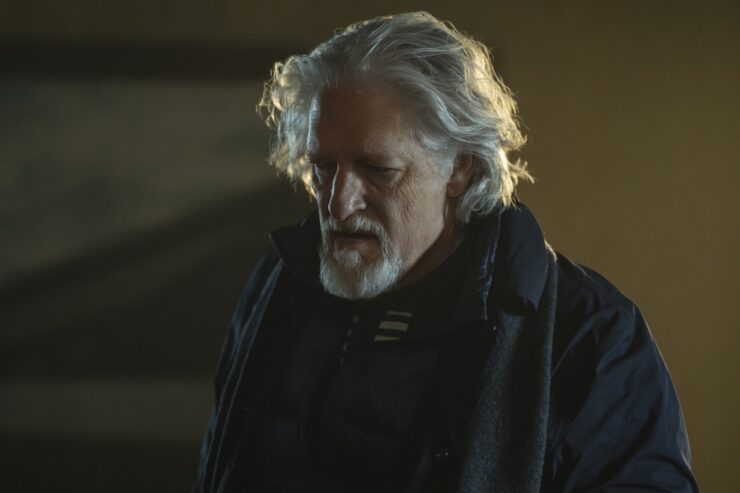
Between writing all (I think) of the Catwoman episodes of Batman and developing the Lynda Carter Wonder Woman TV series, I think it’s safe to assume that Stanley Ralph Ross had a thing for dominatrices.
Also, I utterly love the nasal voice that Julie Newmar says “Robin” with before she goes on to suggest that she and Batman kill him. One of my favorite moments of this series, ever.
They should have had Julie and Lesley duet on “You Don’t Own Me”, sung to a tied-up Batman and Robin (sigh … )
I agree with all of Krad’s criticisms of this two-parter, but I am surprised that he didn’t mention two really glaring ones.
First, how ludicrous it was for Lesley Gore to be the sidekick that Catwoman uses to seduce Robin, given the fact that Ms. Gore was gay. Granted, this was not as well known or probably suspected as Liberace’s sexual orientation was at the time, but still. Maybe that’s why her own acting in this one seemed so wooden. I remember thinking that as an actress, she makes a great pop singer, and “California Nights” is one of my favorites of hers.
Second: no mention of the fact that when Robin is first dosed with cataphrenic, and O’Hara greets him and Pussycat, Catwoman and her thugs are making a pathetic effort to hide literally RIGHT NEXT TO HIM and O’Hara obligingly never notices a thing. If that’s not a crowning moment of the GCPD being utterly ineffective, I don’t know what is.
Weirdly, what bothers me most about this episode was something krad didn’t even point out. When Professor Pending* talks about his perpetual motion machine, his assistant shoots the idea down, not out of skepticism but the fact that this would cause energy suppliers to go out of business (or something to that effect). Sure they would, but with energy no longer something that needed to be harvested, the economy would dramatically even out enough to the point that they could easily get new jobs in a similar field.
*Is this where Wacky Races got the inspiration? It premiered the year after this episode did…
I was thinking the exact same thing about Pat Pending.
His Wacky Races incarnation wasn’t that successful, the
Convert-a-Car ranking only 7th among the 11 vehicles.
Also, this was the only two-part episode during the first
two seasons to be resolved the following week, as it was
broadcast between their only two three-part episodes.
Rudy Valet? Oh, the pain, the pain.
“California Nights” (and Lesley Gore’s earlier hit “Sunshine, Lollipops and Rainbows”) was co-written by Marvin Hamlisch, who went on to become THE movie music guy in the 70s./
I suppose the weakest point in the whole thing is Batman’s lame excuse to take his bat-antidote before Catwoman hits him with the cataphrenic. It’s a slight improvement over him seeming to succumb and then revealing he was fine all along, which is what would have happened in earlier episodes. But would it have been so hard to show him sneaking the pill? Everybody except Catwoman knew exactly what he was doing. It’s a bad case of idiot plotting.
Re: Robin acting as a criminal – one of the weird, somewhat good things about having Asperger’s syndrome (I speak for myself on this) is that I usually can’t tell the difference between “good” acting and “bad” acting. Brainwashed Robin was as convincing for me as Edward Norton pretending (within the film) to be a developmentally disabled man in The Score.
Aside from the Lesley Gore Musical Interlude, this is a strong, fun one from Stanley Ralph Ross. Julie Newmar is in fine form, and I don’t just mean in the obvious sense. And even the whole “I wanna be a singer” subplot wasn’t a total loss. Though it didn’t really work, it was kind of an interesting twist to the formula to get to see a bit of what the henchpeople do in between henching, at least in principle.
What got me was how processed and echoey Pussycat’s voice sounded when she was supposedly singing live to a background music record. Not to mention the mysterious presence of backup singers. (Although I guess they could’ve been on the record?)
And the henchmen are Spade, Marlowe, and Templar, named for detective characters. An odd choice. I’d imagine Spade is a pun on “spayed” and the others were by association.
Now, how is it that a young but no doubt well-trained crimefighter like Robin could give a whole speech in a school auditorium without noticing Catwoman and her whole gang standing in clear view just offstage? That mask must really cut off the peripheral vision.
Okay, Batman, I can understand wanting to deal with Robin yourself, but couldn’t you have let the cops handle the henchmen while you went after the Boy Wonder? Although I do find something genuinely touching about how Batman can’t bring himself to hit Robin under any circumstances.
That giant scale is recycled from the Penguin-for-Mayor episode!
Man… that’s definitely Julie Newmar doing her own stunts in the climax there. No abrupt transformation to a stockier figure like with Lynda Carter’s Wonder Woman. (At the time of Batman, I don’t think there were any female stunt performers in the business — certainly vanishingly few.) There was no end to Newmar’s talents.
If I may digress for a bit… I realized after watching these episodes that there’s something really disturbing about the Gotham City justice system in Batman ’66. The big-name supervillains keep getting paroled after mere months or weeks no matter how severe their crimes… and yet we never see any of the same henchmen or molls returning, which suggests they’re all just languishing in jail indefinitely. How come the low-level thugs get tougher sentences than the evil masterminds? Is it because the colorful celebrity villains can get better lawyers? Or are they just better at fooling Warden Crichton and the parole board into thinking they’ve reformed?
Or, to consider an even darker possibility… Generally it’s the mooks who do most of the fighting with Batman and Robin while the special guest villains watch (though the Joker, Penguin, Riddler, and others generally do join in the fights). Could it be that the mooks are too badly injured after their final confrontations with the Duo to continue their lives of physically active crime?
Then again, a more optimistic interpretation is that the mooks and molls all go straight after their brushes with Batman, and have gone on to live as productive members of society. This is often explicitly the case with the molls — those poor, deluded creatures have simply been led astray, and often have changes of heart. Maybe the henchmen go straight as well, but Bruce Wayne isn’t quite as motivated to take a, err, personal interest in their rehabilitation.
Then again, there are a few actors who played multiple different goons in different episodes, including Joe E. Tata, Tony Epper, and George Sawaya (the latter two of which were in this one). Given that the goons all have themed nicknames to fit the villains of the week, it’s possible that these are the same career henchmen under different aliases. In which case the parole situation for henchmen isn’t quite as bad as it seems.
“Robin is giving a commencement speech at Aaron Burr High School. (Why someone who hasn’t actually graduated high school yet is giving a high school commencement is left as an exercise for the viewer.)”
To be fair, they probably just assumed Robin was over twenty already. Who could blame them?
@8/NapoleonDeCheese: Except that he’s constantly addressed as “Robin, the Boy Wonder.” In fact, in the show, Batman is pretty much the only person who just calls him Robin — everyone else generally calls him “Boy Wonder” to his face and “Robin, the Boy Wonder” when speaking about him. And when we’ve seen Robin speaking to the public in the show, he generally acknowledges that he’s a teenager. I think that in “The Joker Goes to School,” he was open about being a high school student, though he didn’t reveal which school he was in.
I didn’t know it was ludicrous for gay actors to portray noon-gay characters. Maybe only until 1969?
The henchmen are probably fired and replaced. It is an Evil trope that failure is never tolerated, and evil hirelings don’t get to learn from mistakes EVER. Unless they are killed offscreen.
I was touched by the Bat/ Cat talk near the end, and was feeling hopeful- until the totally clueless “Kill Robin” bit.
David: I didn’t mention that it was absurd for Gore to play a character who seduces Robin for the same reason that I didn’t mention that it was absurd for Zachary Quinto to play a character who’s dating a character played by Zoe Saldana when I reviewed the last two Trek films — because it isn’t even a little absurd. It’s called acting.
—Keith R.A. DeCandido
Krad: point taken. But as I said, Gore’s performance was pretty wooden here and unconvincing, even when I was a kid and didn’t know she was gay. And you did mention Liberace’s efforts to pass himself off as a ladies’ man in your review of “The Devil’s Fingers” so it struck me as odd you didn’t point out the same thing here. No offense meant; a better actress that happens to be gay might have done a better job than Gore did here.
With Quinto and Saldana, it works better because Quinto is a better actor. In fact until just now I didn’t even know Quinto was gay. I also didn’t know when I first watched him on “Bewitched” that Dick Sargent was gay, and I had no trouble believing his kissing scenes with Elizabeth Montgomery.
I guess what I should have said is that Gore didn’t make me believe it as Quinto and Sargent did and left it at that. I apologize for having done that so clumsily.
The idea of Catwoman turning Robin was an interesting plot, but as a plot device it failed in one major missed opportunity.
The first thing she should have made Robin do was take off his mask. And this isn’t the first time the villain had an opportunity to discover who Batman and Robin are, and totally blew it. Dumb villains.
@13/richf: You can say the same about several thousand other superhero stories over the decades, including just about every episode of this series where the villains capture B&R or render them unconscious before putting them in a deathtrap.
Great Rewatch, krad. Hope your apartment woes are over.
I agree with commenter RichF–the difference in this storyline is that Catwoman has Robin in her custody, so to speak, for the bulk of the episode. There at least should have been a line of dialogue that covers why she doesn’t remove the mask in all that time. It also doesn’t jibe with the fact that she obviously wants to go to the Batcave so she can figure out who Batman is, which makes her failure to remove Robin’s mask all the more glaring given that context.
@15/J.P. Pelzman: Wasn’t there something in this episode where someone asked Robin to take his mask off but he resisted because he instinctively sensed that he shouldn’t? Or maybe that was some other story where he was co-opted by the villains. In any case, I think it was addressed, if not here, than somewhere.
CLB–I’d have to go back and check, but I don’t remember any such line in this episode. Perhaps in another one.
Even a line lampshading the failure to take off his mask would have been an improvement, IMO.
Just discovered something fascinating. There’s a site with some–not nearly all–of the paperwork for the show, and there is a Dec. 8, 1966 note from ABC Standards and Practices, i.e., censors, that says in part, ‘page 3, scene 6 POISON IVY’s undulating out of frame–acceptably of course.’ (their CAPS, not mine)
So the original shooting script had Poison Ivy (!) as Catwoman’s sidekick. WOW! I wonder whom they had in mind for the role before they decided to go the nepotism route.
I agree with something krad said–the plot ground to a halt every time Lesley sang. It’s sad, IMO, that by this time the show was being used a vehicle to plug other things.
@13, 14, & 15: Not that this really applies to the TV show, but I think it’s explained, implicitly or explicitly, in some stories that the Joker actually prefers to not to know (or is psychologically incapable of knowing) Batman’s identity because it’s a status quo he’s comfortable with. As for the other villains, I’m not sure. Maybe Batman has high-tech locks in some versions of the Batsuit that make his cowl impossible to remove by anyone who doesn’t have the combination.
@18: The Poison Ivy of the comics (of today, at any rate) would be mightily pissed off at being called anyone’s sidekick, LOL.
@18/J.P. Pelzman: I have to wonder if that was the same Poison Ivy from the comics or just a coincidentally like-named character. After all, Poison Ivy debuted in the comics in 1966 and only made two appearances prior to the date of that memo. So while the character did exist at the time, the makers of the show weren’t exactly big on borrowing from the contemporary comics at that point. A number of first-season episodes had been adapted from comics stories that were recent, or recently reprinted, at the time, but the second season relied more on original villains.
Then again, Ivy’s second appearance was in an issue whose cover promoted the TV series, so it’s possible there was a bit of cross-pollination going on. Maybe the producers were looking for a new female villain and they heard that the comic was trying to establish Ivy as a new femme fatale. So I guess it’s possible. It wasn’t that much later, after all, that they asked the comics’ creators to come up with a Batgirl character they could adapt to the screen. And this episode does involve women mind-controlling men, so it’s plausible that it could’ve been conceived as a Poison Ivy vehicle.
Of course, the original Poison Ivy didn’t have her modern plant powers. In her first appearance, she was basically a normal human thief who used a hypnotic lipstick to brainwash men with her kiss and who also could apparently use her hair as a weapon in a variety of ways (??). Basically your stock villainess with weaponized sexuality, the same schtick the show gave us with Marsha, Queen of Diamonds and the Siren.
I would suggest the problem with Ms Gore’s performance was that she just wasn’t an actress.
Also, Jersey and Guernsey are Channel Islands (the geographic origin of the cattle breed names, of which a third was Alderney).
@22/stillCMK: Yup. New Jersey is, of course, named after the Channel Island of Jersey, so that’s the basis for the New Guernsey pun in the episode.
@10/sps I know I’m swimming against the tide on this, but I agree–the ‘kill Robin’ bit was silly. Unlike most people, I hated it.
@21/CLB As you say, Ivy was much different in her early days, so it’s quite possible it would have been Ivy’s job to seduce Robin rather than Pussycat doing it. You make an interesting comment about ‘weaponized sexuality.’ I, personally, liked Siren a lot, but I can discuss that when krad gets to that arc.
And I agree with krad that Burt Ward’s acting as a bad guy is terrible. In the scene when he is supposed to be cutting the string to kill Batman, he plays it like John Carradine in a 1940s mad-scientist movie. Director Oscar Rudolph helmed some terrible over-the-top performances, and this was one of them, along with Terry Moore, Rudy Vallee, Barbara Rush and Anne Baxter as Olga, IMO.
@7/CLB: Warden Crichton probably employs Themyscirans to work on the henchmen.
@24/J.P. Pelzman: There’s an ancient misogynistic trope that female sexuality is a dangerous power that will emasculate manly men if they allow themselves to fall prey to it — the idea goes back to mythological figures like the Sirens and Circe and was the basis of the fear that motivated the Salem witch trials. The idea that female sexual power is a threat to male autonomy is the reason female sexuality has been so forcefully regulated, suppressed, and even criminalized in patriarchal cultures. So there’s always been a tendency in fiction to portray female villains defined by their sexual allure and ability to enslave the will of men, as seen in Batman with Marsha and the Siren. Even the upcoming Black Widow episodes are a variation on that theme, casting legendary screen vamp Tallulah Bankhead as a mind-controlling villainess, but desexualizing it on account of her advanced age.
And you see it in other franchises as well. Star Trek stories, especially those conceived by Gene Roddenberry, gave us the green Orion women with their dangerous animal seductiveness, Nona the Kanutu witch woman with her primal ability to enthrall men, Elasian women with their love-potion tears, and Deltan women so erotically advanced that sex with them could drive a mere human mad.
I do apologize most profusely, but I have to delay the Bat-rewatch again, this time due to another deadline. If it wasn’t another three-parter, I might’ve been able to swing it, but it was just too much on top of the project (which I can’t say what it is, but it’s really really cool…..).
Anyhow, we’ll be back on track next week with “Penguin is a Girl’s Best Friend”/”Penguin Sets a Trend”/”Penguin’s Disastrous End.”
—Keith R.A. DeCandido
Hasn’t Gordon spoken to Alfred over the Bat-phone when the latter has to explain that Batman isn’t available or stuff like that?
@7 – Chris: I believe Bruce Wayne helps rehabilitate the henchguys but through his foundation, and not personally. That’s why we never see them again.
@12 – David: I just find quite funny that a guy named “Dick Sargent” was gay. :)
@19 – RWF: In the comics, modern ones at least, Batman’s cowl has devices that electrocute and/or gas anyone who tries to remove it without knowing a specific way to do it.
Just so everyone knows, I’ve written and uploaded the rewatch for “Penguin is a Girl’s Best Friend”/”Penguin Sets a Trend”/”Penguin’s Disastrous End,” so it should go up tomorrow at 3.
—Keith R.A. DeCandido, happy to be back on track
Good on Batman for not fighting back against Robin. If Robin had been convicted for his wrongdoings, he would have to be revealed as Dick Grayson and then Batman would on trouble for hitting a minor.
@30/Cam: As I said in comment #9, I think it’s pretty common knowledge that Robin, the Boy Wonder is a minor, with or without knowing his real name.
#BatFunFact: “That Darn Catwoman/Scat! Darn Catwoman” and “The Ogg And I” marked the only times on the whole Batman TV series wherein The Dynamic Duo remained in-costume during the whole ordeal! Not once do you see Bruce Wayne and/or Dick Grayson appear in any of these segments.
Nice fact.